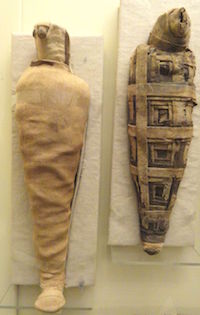Mummification was not a process which was reserved for people in ancient Egypt. In fact, we have discovered several million more animal mummies than human mummies! Animals mummies come in four main types; the mummies of pets, the mummies of sacred animal, animals mummified as offerings to a god who was associated with that animal, and mummies that were burial provisions placed in or near the tomb of a deceased person.
The earliest example of animal mummies are the predynastic burials at Tarkhan of donkeys and ducks, each provided with their own coffins. The necropolis at Hierakonpolis contained an amazing array of animals including elephants, cattle, baboon, wildcats and hippopotamus. One elephant (buried during the Naqada II Period) was laid to rest under the earliest example of an elaborate burial superstructure. There is evidence that attempts were made to mummify these animals (this was early in the development of mummification).


A number of the rulers of the first dynasty were buried at Abydos alongside lions and donkeys. Four hunting dogs were also buried there, each with their own funerary stele. While the dogs seem to have merited some affection from their owners, they (like the lions and donkeys) may have been killed in order to be buried with their owners. After all the first dynasty kings also had many of their subjects killed and interred around them. Thankfully, that practice was soon abandoned.

In later times, we also find examples of animals buried close to the tombs of the powerful where it is not clear whether the animals were viewed as pets or carried some religious significance. For example, the mummies of dogs and monkeys in the Valley of the Kings are not linked to a specific tomb (although they are close to the burials of Horemheb and Amenhotep II). The baboons had had their canine teeth removed to prevent them from biting (which was not generally done with the sacred baboons kept by a temple). Furthermore, the type of mummification of these animals suggests that they were cared for as individuals. The mummified bodies of a baboon and a horse were found outside the Theban tomb of Senenmut, and a mummified monkey was found outside Theban Tombs 11 (the grave of the overseer Djehuty) and 12 (the tomb of the overseer Hery).
Sacred Animal Mummies
A huge number of animals were mummified because of their perceived connection with a god. In some cases, such as the Apis Bull, the Mnevis Bull and the Buchis Bull, the animal was considered to be the incarnation of a god and lived in the lap of luxury before dying of natural causes and being mummified with care and buried with great honours. The earliest intact Apis Bull burial so far discovered dates to the reign of Horemheb, but surprisingly it only consisted of the preserved head of a bull resting on a mass of resin, bone fragments, and gold leaf which had been shaped to form the body and wrapped in linen.

It is thought that the body of the bull may have been consumed as part of the funerary ritual, but later Apis Bulls seem to have been buried in their entirety. The Cannibal Hymn of the Pyramid Texts does make reference to the king “devouring” the gods to take on their power, but we have no specific reference to sacred animals being eaten, so there may be another explanation for the Apis’ missing body.
Other animal mummies with a divine connection include crocodiles (sacred to Sobek), hawks and shrews (sacred to Horus), baboons (sacred to Thoth), rams (sacred to Khnum), dogs or jackals (sacred to Anubis), and cats (sacred to Bast) . For these animals the line between a sacred animal and an animal bred specifically so that they could be killed, mummified, and offered to the god with whom they were associated is unclear. Mummies of a number of rams from the necropolis of Elephantine show signs of osteoarthritis which suggests that they may have been kept in an enclosed dark space while alive, and many cat mummies show the signs of intentional killing (usually strangulation or blunt force trauma).

Interestingly, numerous fake mummies have been recovered. These have been wrapped to resemble the mummy of an animal (usually a cat or a falcon) but there is no body inside the wrapping. We don’t know whether this was the result of con men selling allegedly true mummies, or done with the full knowledge of the temple and those offering to the gods. It has also been suggested that these mummies are not real fakes, but rather they are composed of the detritus left by sacred animals (rather like the jumble found in an embalmers cache). However, if this is the case, why do we find the bits and pieces of animals being carefully bandaged, while the equivalent remains from human burials are simply discarded? Perhaps further examination of the thousands of animal mummies in museums across the world will provide us with more answers.
Bibliography
- Dunand, Françoise and Lichtenberg, Roger (2006) Mummies and Death in Egypt
- Ikram, Salima (2003) Death and Burial in Ancient Egypt
- Ikram Salima “Divine Creatures” (2005)) in Divine creatures: Animal Mummies in Ancient Egypt, Edited by Salima Ikram
- Reeves, Nicholas and Wilkinson, Richard H. (1996) The Comlete Valley of the Kings
- Strudwick, Nigel and Helen (1999) Thebes in Egypt
copyright J Hill 2017